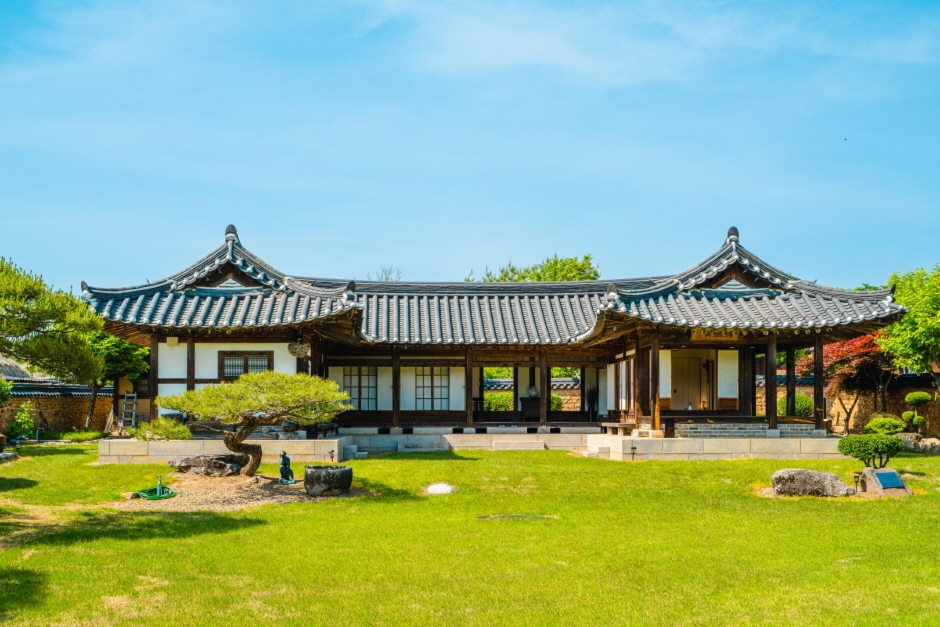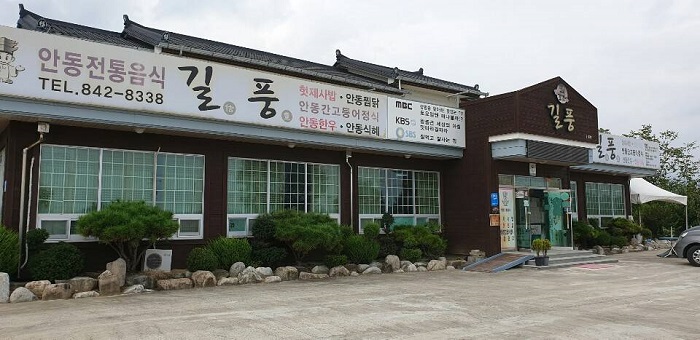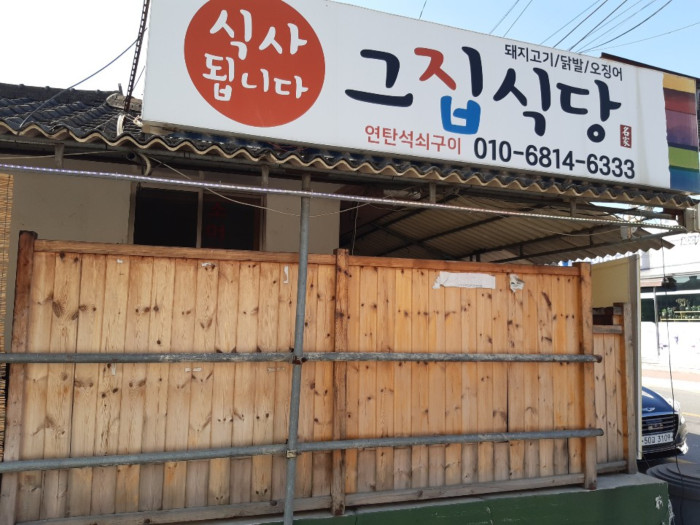Ga Gyeong Jae [Korea Quality] / 가경재 [한국관광 품질인증]
2.8Km 6577 2023-04-13
69-5, Hahoenamchon-gil, Andong-si, Gyeongsangbuk-do
+82-54-855-8552
Gagyeongjae, or House with a Beautiful View, is a place with a thatched roof and an unhindered view. Guests can enjoy the view of natural environment over the window, with cool breeze freely flowing in the rooms. There are five rooms in total including Anchae Sangbang, Sarangchae Upper Room and Lower Room, Ondol Red Clay Lower Room, and Door Room. Guests in Anchae can use the central porch, whereas guests in Sarangchae can take advantage of the central floor as well. Ondol Red Clay Room is popular; it is heated by the owner himself through the traditional fireplace outside the room. The room, however, requires reservation at least 2 days in advance.
Air conditioners were recently installed in the hanok. Additional fees are separately charged in summer, but it is just great to enjoy air conditioning in a hanok. Note that reservation and inquiry over the phone is faster and more convenient than that on the website. There are many restaurants and places to experience in Hahoe Folk Village. It is a nice place to enjoy many things and just relax.
Bukchondeak [Korea Quality] / 하회 북촌댁 [한국관광 품질인증]
2.9Km 115761 2020-09-08
7, Hahoebukchon-gil, Pungcheon-myeon, Andong-si, Gyeongsangbuk-do
+82-54-853-2110, +82-10-2228-1786
Located in Hahoe-ri (Pungcheon-myeon, Andong-si, Gyeongsangbuk-do), Hahoe Bukchondaek House is a hanok stay that was originally built by a civil official named Ryu Sa-chun in 1797 (the 21st year of the reign of King Jeongjo of the Joseon dynasty). It consists of a small sarangchae (men’s quarters) with two wing buildings at sides. As the anchae (women’s quarters), large sarang, daemungan (gate building), and shrine were built by Ryu’s great-grandson, Ryu Do-seong (who served as a governor of Gyeongsang-do), in 1862 (the 13th year of the reign of King Cheoljong), the house displays the typical features of a Joseon nobleman’s house and is the largest in Hahoe. The large sarangbang, Bukchonyugeo (measuring 7-kan* at the front, 3-kan at the sides), consists of two 2-kan rooms, two 1-kan rooms, a 4-kan daecheong (wooden floor), a 3-kan numaru (upper floor), a 3-kan kitchen, a 3-kan garret, a 5-kan toe (the narrow wooden veranda running along the outside of the building), and a jjokmaru (narrow wooden veranda). The entire building can be converted into a single space simply by opening the sliding doors between the rooms and the doors between the rooms and the daecheong. The medium-sized sarang, Hwagyeongdang, consists of a 2-kan room, a 1-kan daecheong, a 3-kan toe, and a jjokmaru, while the small sarang, Susinwa, consists of a 1-kan room, a 1-kan daecheong, and a 2-kan toe. The anchae has a courtyard in the middle, a kitchen, a main room, a daecheong, a gobang (storeroom), a witsangbang (upper room), a toenmaru (a narrow wooden porch running along the outside of the building), an araetsangbang, a jungmun that links to the large sarang, an araetgwang (storeroom), a dwiju (grain-chest), and a munganbang (gate building room). The munganchae (gate building) and shrine are also situated within the grounds of the house, along with a 300-year-old pine tree that is known for its curved shape, which is said to resemble the Nakdonggang River as it meanders around the village of Hahoe. The house contains valuable cultural heritages including Doseongpaldojido (Map of the Eight Provinces of Korea), which is estimated to date from the seventeenth century, and is regarded as an invaluable historic material as it includes Dokdo Island and Jiandao as part of the Korean territory, and a painting titled ‘Sehwa,’ which is believed to have been given to Ryu Yi-jwa (pen-name: Hakseo, 1763-1837) by the king as a New Year’s present. Bukchondaek House was built by one of the richest families in Hahoe, who are well known for their generosity as they have helped local people on many occasions throughout history. *kan: a unit of measurement referring to the distance between two columns.
Aldea Hahoe de Andong (안동 하회마을) [Patrimonio Cultural de la Humanidad de la Unesco]
2.9Km 16674 2024-07-18
Hahoejongga-gil 2-1, Pungcheon-myeon, Andong-si, Gyeongsangbuk-do.
La aldea Hahoe de Andong ha preservado la arquitectura de las casas y la estructura de una aldea tradicional de la dinastía Joseon. Asimismo, hay que destacar que la aldea no fue creada en forma artificial; hay gente que realmente vive allí.
El río Nakdonggang rodea tres de los cuatro flancos de la aldea Hahoe (Material Tradicional de Importancia). La aldea lleva el nombre de Hahoe porque el río forma un remolino alrededor de la misma y también se la conoce con el nombre de Aldea del Río Circular. Al lado de la aldea crecen numerosos pinos y se extiende un llano de suave arena, y frente a este se despliegan bellísimos acantilados. Esta aldea pasó al conocimiento público por una escuela confuciana de la dinastía Joseon (1392-1910), de los maestros Gyeomam (seudónimo de Ryu Un-ryong, 1539-1601) y Seoae (seudónimo de Ryu Seong-ryong, 1542-1607), que realizaron grandes hazañas durante la Guerra de Imjin en 1592.
Gracias a que la aldea está rodeada de las montañas y el río, nunca ha sufrido una invasión. Esta es la razón porque sus casas siguen conservando sus estructuras originales. En la aldea residen 180 familias y son conocidas como el Grupo de la Aldea, pertenecientes a la familia Pungsan Ryu. Dentro de ella, hay casas que fueron designadas Tesoros Nacionales, como por ejemplo Yangjindang y Chunghyodang. Asimismo, hay material importante de tradiciones, como la Casa Hahoe Bukchon, la Casa Hahoe Namchon y Hahoe Juilje. Las casas así designadas calificadas ayudan a preservar el estado original de la aldea de la familia Ryu, especialmente sobre los pilares de referencia de Ryu Un-ryong y Ryu Seong-ryong.
La aldea Hahoe es también famosa por el exorcismo Byeolsingut, la danza de máscara y la Máscara Hahoetal. La Máscara Hahoe-Byeongsantal es la más antigua de Corea y se la usa en la Danza de Máscaras Byeolsingut. La Aldea Hahoe se volvió más popular desde la visita de la Reina Isabel II del Reino Unido en 1999, y durante este tiempo se ejecutaron muchos eventos de Danza de Máscaras.
El Festival Internacional de Danza de Máscaras de Andong tiene lugar entre fin de setiembre y principios de octubre, a lo largo de 10 días aproximadamente, dentro de la Aldea Hahoe y otras áreas designadas.
Garam Choyeonjae [Korea Quality] / 가람초연재 [한국관광 품질인증]
3.0Km 16442 2020-09-09
76-6, Hahoejongga-gil, Pungcheon-myeon, Andong-si, Gyeongsangbuk-do
+82-10-3849-7542
Garam Choyeonjae offers guests a variety of charming features, particularly the harmonious natural environment which creates a serene and relaxing atmosphere. Situated in Hahoe, which is partially enclosed by the Nakdonggang River, Garam Choyeonjae stands out among the village’s many hanok houses due to its beautiful thatched roof. The village has become a popular tourist destination thanks to the distinguished natural landscape along the Nakdonggang River, its 100 ~ 200-year-old hanok houses, and nearby Buyongdae Cliff, which commands a panoramic view of the village. The name of the house is a compound word consisting of ‘garam’, which is the pen-name of the house’s owner, a 15th–generation descendant of Ryu Seong-ryong (pen-name: Seoae, 1542-1607, a scholar-official of the Joseon Dynasty), and ‘choyeonjae’, which means “a thatched house in which swallows live.” Guests can even see the swallows and their nests under the rafters and eaves of this simple, cozy hanok. The house is also surrounded by various well-known buildings such as Damyeonjae House, the largest and oldest hanok in the village; Yangjindang House (Treasure No. 306); and Binyeonjeongsa House (National Folklore Cultural Heritage No. 86), which was built and used as a library by Ryu Un-yong (pen-name: Gyeomam). Garam Choyeonjae consists of two rectangular hanok buildings with clean and well-maintained rooms exuding a traditional and antique atmosphere. In particular, the house’s beautifully maintained thatched roof attracts many foreign visitors. The house also provides various experience programs, including an opportunity to use a treadmill, millstone, and mortar, and a gat-making experience (a gat is a Korean traditional hat made of bamboo and horsehair). Moreover, visitors are highly recommended to appreciate the fantastic view of the sunset from the wooden floor of the house’s sarangchae (men’s quarters), and the beautiful garden planted with seasonal wildflowers.
Damyunjae (담연재)
3.0Km 0 2023-08-22
Hahoejongga-gil 76-3, Andong-si, Gyeongsangbuk-do
Gilpung (길풍)
3.3Km 45 2021-03-23
8, Nabau-gil, Andong-si, Gyeongsangbuk-do
+82-54-841-9967
It is a clean and delicious restaurant, selected by the Korea Tourism Organization, where you can taste Andong's local food. This restaurant's signature menu is Andong braised chicken. This Korean dishes restaurant is located in Andong-si, Gyeongsangbuk-do.
Academia Neoconfuciana Byeongsan Seowon (병산서원) [Patrimonio Cultural de la Humanidad de la Unesco]
3.7Km 31596 2024-05-07
Byeongsan-gil 386, Pungcheon-myeon, Andong-si, Gyeongsangbuk-do
Byeongsan Seowon es una academia neoconfuciana que fue fundada para honrar la memoria de Seong-nyong Yu (1542-1607), un personaje respetado por su carácter y por sus escrituras. En 1863, este tipo de escuelas tenían muchas libertades bajo las leyes Joseon, incluso no debían pagar impuestos y otros gastos. El río Nakdonggang está situado justo enfrente de la academia. Si se cruza, se llega hasta el monte Byeongsan.
Songgyehyeon [Korea Quality] / 송계헌 [한국관광 품질인증/Korea Quality]
3.8Km 0 2021-03-25
332, Byeongsan-gil, Andong-si, Gyeongsangbuk-do
This hanok (traditional Korean House) lies only 500 m away from Andong’s Byeongsanseowon Confucian Academy. Byeongsanseowon Confucian Academy is one of the Confucian academies (Joseon-era places of learning and veneration of Confucian scholars) registered as a UNESCO World Heritage, and is particularly known for its beautiful harmony with the surrounding nature. Songgyehyeon likewise faces the Nakdonggang River to the front, and a 330 m-high mountain to the back, displaying the characteristic harmony of hanok with nature.
The house was named Songgyehyeon by the owner, who wanted to build a house made out of pine trees (“song”). The entire house is offered for rent, which makes it ideal for families and groups. Songgyeheon follows a strictly traditional structure of hanok, as evident in its hipped-and-gable roof, but its interior is equipped with comfortable modern facilities. The house includes both bedrooms and Korean-style ondol (under-the-heating system) rooms. One of the three bedrooms available has a queen-sized bed, while the remaining two are equipped with comfortable mats. The common space, spacious enough to host a group, has a high ceiling dominated by exposed beams. The kitchen is equipped with cooking equipment like refrigerator, gas stove, microwave oven, and utensils for guests to cook their own food. The owner of the house also enthusiastically provides detailed information on Andong’s many tourist sites.
Geujip Sikdang (그집식당)
4.3Km 128 2021-04-13
2, Yeokjeon 1-gil, Andong-si, Gyeongsangbuk-do
+82-54-841-3331
It is a place where you can enjoy various Korean side dishes. This restaurant's signature menu is kimchi stew. This Korean dishes restaurant is located in Andong-si, Gyeongsangbuk-do.
Dawoo Motel [Korea Quality] / 다우모텔 [한국관광 품질인증/Korea Quality]
4.4Km 1 2023-04-13
66, Jangteojungang-gil, Andong-si, Gyeongsangbuk-do
+82-54-858-9100
Dawoo Motel is located in a lively street located in Pungsan-eup, Andong-si, and serves as a popular accommodation for visitors to Hahoe Village thanks to its affordable rates.
The five-story building houses 25 rooms, with the maximum occupancy of 50. The rooms are available in both Korean and bedroom styles. Bedrooms, which have beds and sofas, have a standard occupancy of 2 and a maximum of 3, while the twin room has a maximum occupancy of 4. Korean rooms have a standard occupancy of 2, but various ondol (under-the-floor heating system) rooms can house up to 5, 6, and 7 guests. Dawoo Motel thoughtfully requires no additional surcharge for additional guests in ondol rooms.
Not all rooms have bathtubs, so guests are advised to contact the front desk for their reservation. Guests are offered complimentary bottled water, beverages, and coffee. All rooms are furnished with TV, refrigerator, air conditioning, towels, basic toiletries, and hair dryer. Pets are allowed in the room, and services are also offered in English. Hahoe Village and Byeongsanseowon Confucian Academy, which were inscribed as UNESCO World Heritage, can be reached by car in 20 min.
![Ga Gyeong Jae [Korea Quality] / 가경재 [한국관광 품질인증]](http://tong.visitkorea.or.kr/cms/resource/00/2626200_image2_1.jpg)
![Bukchondeak [Korea Quality] / 하회 북촌댁 [한국관광 품질인증]](http://tong.visitkorea.or.kr/cms/resource/74/2626274_image2_1.jpg)
![Aldea Hahoe de Andong (안동 하회마을) [Patrimonio Cultural de la Humanidad de la Unesco]](http://tong.visitkorea.or.kr/cms/resource/43/2654743_image2_1.jpg)
![Garam Choyeonjae [Korea Quality] / 가람초연재 [한국관광 품질인증]](http://tong.visitkorea.or.kr/cms/resource/43/2579443_image2_1.jpg)



![Songgyehyeon [Korea Quality] / 송계헌 [한국관광 품질인증/Korea Quality]](http://tong.visitkorea.or.kr/cms/resource/42/2706142_image2_1.jpg)

![Dawoo Motel [Korea Quality] / 다우모텔 [한국관광 품질인증/Korea Quality]](http://tong.visitkorea.or.kr/cms/resource/01/2709201_image2_1.jpg)
 Español
Español
 한국어
한국어 English
English 日本語
日本語 中文(简体)
中文(简体) Deutsch
Deutsch Français
Français Русский
Русский